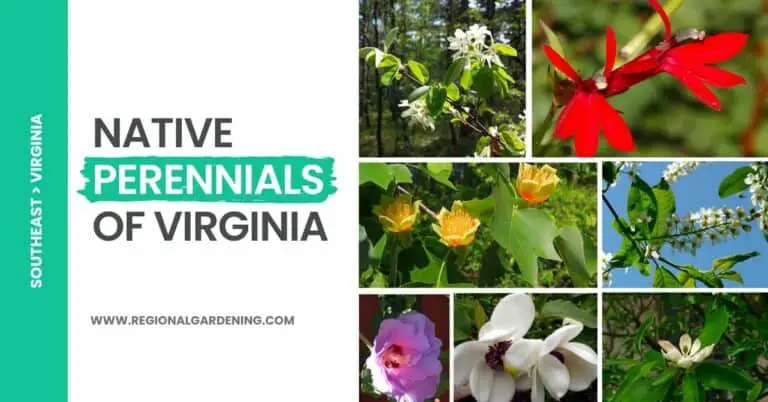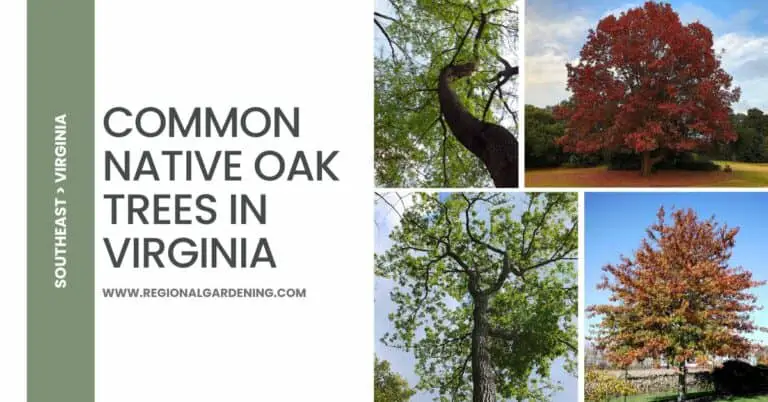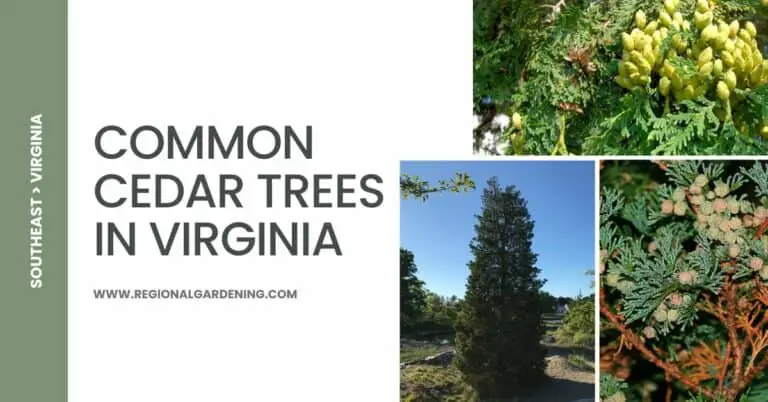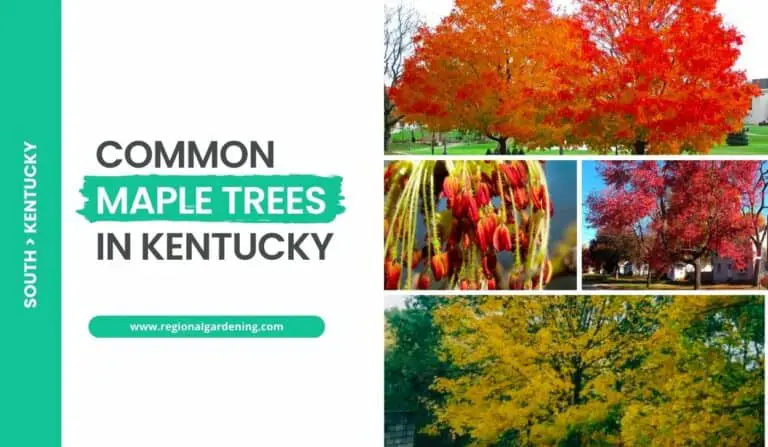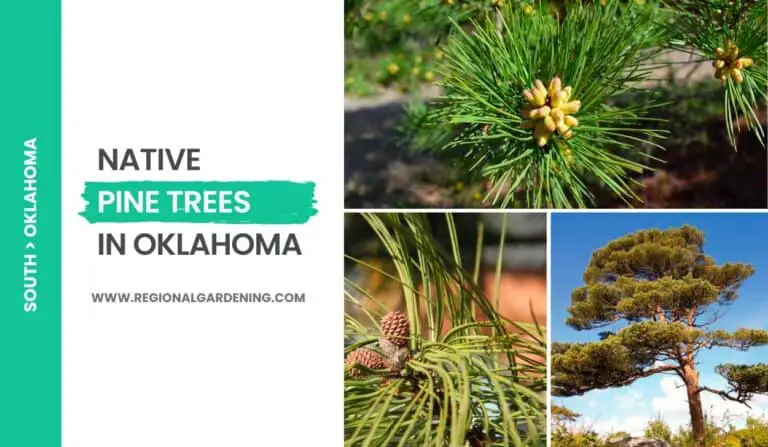Native Berry Trees In Kentucky (Photos & Identification)
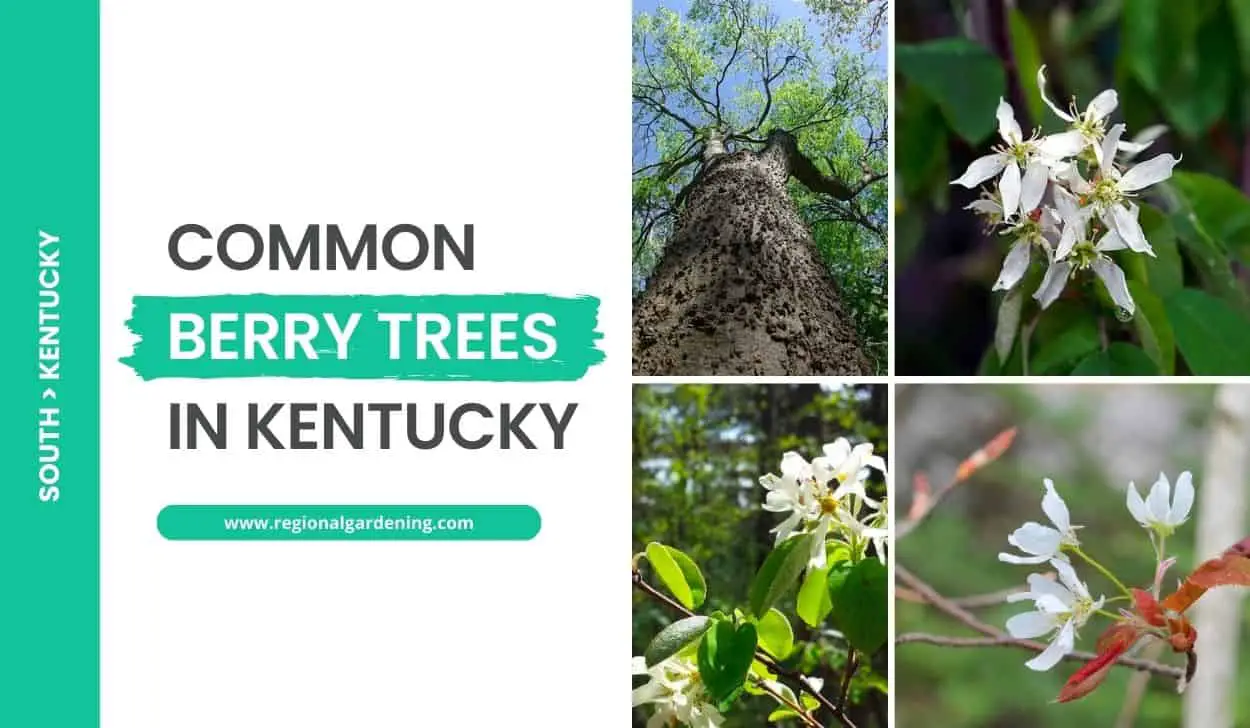
Native berry trees may be the answer if you want to add a burst of sweetness to your Kentucky garden. These hardy trees not only produce delicious fruits but also add aesthetic appeal with their blossoms and vibrant fall foliage.
In this article, we will look at three varieties of native berry trees in Kentucky that are perfectly adapted to the state’s climate and soil conditions. Each tree is highlighted with high-quality imagery and detailed descriptions that cover topics such as identification features, native habitats, and geographical range.
So, let’s begin.
1. Allegheny Serviceberry
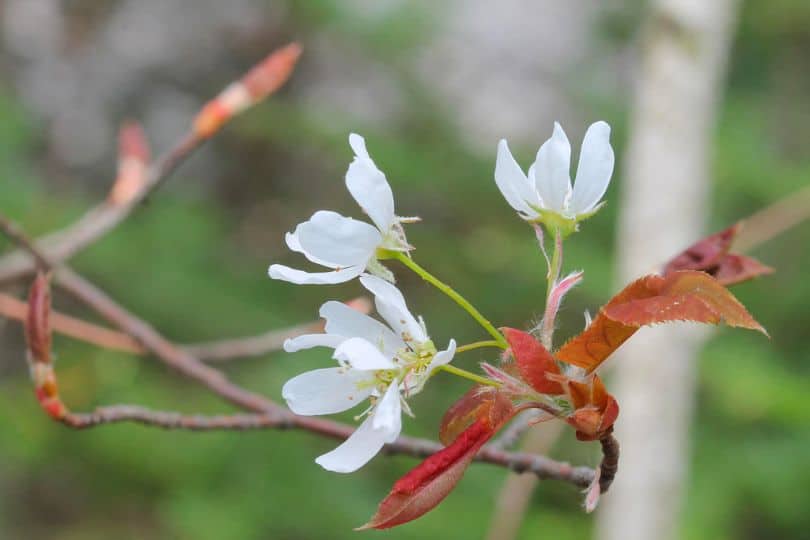
- Scientific Name: Amelanchier laevis
- Common Name(s): Allegheny Serviceberry
- Mature Height: Up to 25 feet
- Native Region: Eastern North America
- Flowers: White, borne in panicles up to 4 inches long
- Fruit: Black, sweet, attracts birds
- Uses: No specific uses are mentioned in the provided context, general landscape ornamentation might be inferred
The Allegheny Serviceberry, formally known as Amelanchier laevis, is a tiny tree with several stems that can grow up to 25 feet tall. This tree is endemic to Eastern North America and can be seen in many Kentucky environments. It grows in an oval to upright vase shape, making it a popular choice for ornamental planting.
Allegheny Serviceberry blooms in the spring with huge white flowers grouped in panicles up to 4 inches long. These flowers produce bluish-green fruits that are dark, tasty, and very appealing to birds.
Allegheny Serviceberry leaves are alternating, simple, and range in length from 1 1/4 to 3 inches, with serrate margins. The leaves emerge purplish at first and then turn dark green throughout the summer. One of the tree’s distinguishing characteristics is its spectacular fall foliage, which can be orange, red, or yellow and adds a colorful touch to the autumn environment.
Allegheny Serviceberry grows best in partial shade and requires little care. Planting it in full sun in arid locations may stress it out. It prefers well-drained loam or sand that is mildly alkaline to acidic. Heavy nitrogen fertilizer should be avoided because it can exacerbate concerns like fire blight, a prevalent disease afflicting this species. The tree is winter hardy to USDA Zone 4, making it suited for Kentucky’s environment.
While the specific functions are not specified in the context, Allegheny Serviceberry is often used as a landscape attractive tree, particularly when planted against an evergreen background.
Its appealing white spring blossoms, vibrant fall foliage, and bird-attracting fruits make it a popular choice with Kentucky gardeners and landscapers. Its healthy growth in the state’s landscapes can be ensured by paying close attention to its habitat requirements and disease prevention methods.
2. Downy Serviceberry
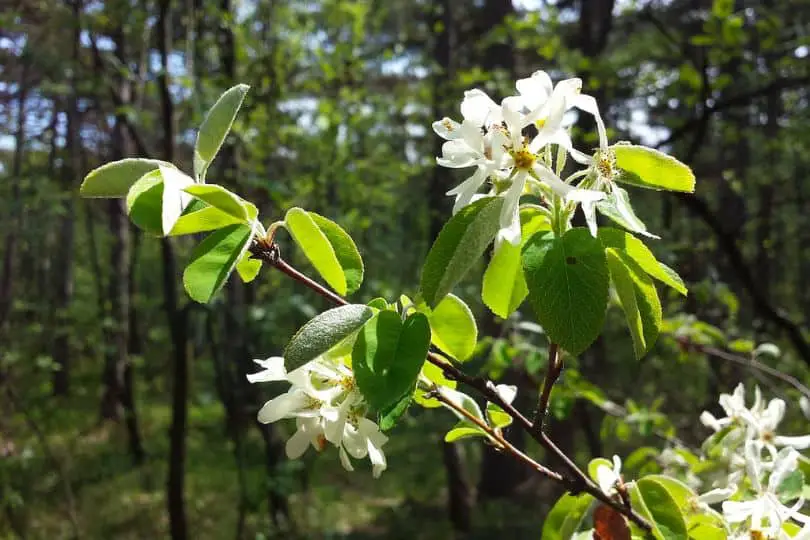
- Scientific Name: Amelanchier arborea
- Common Name(s): Downy Serviceberry
- Mature Height: 15 to 30 feet
- Native Region: Maine to Iowa, as far south as northern Florida to Louisiana
- Flowers: White, fragrant flowers borne in 2- to 4-inch-long pendulous racemes in early spring
- Fruit: Berry-like pome, 1/4- to 1/3-inch in diameter, changing from green to red to purplish black; ripens in June
- Uses: Wood is heavy and valuable, fruit used in pies and sweetbreads, can be dried like raisins, used for making tea, and native Americans used the wood for arrow shafts
Downy serviceberry, scientifically known as Amelanchier arborea, is the tallest of Kentucky’s native serviceberries, reaching heights of 15 to 30 feet. Its fragrant white flowers bloom in early spring, grouped in pendulous racemes 2 to 4 inches long.
The tree produces berry-like pomes that ripen in June and range in color from green to red to purplish black. It has alternating, simple, medium to dark green leaves that are 1 to 3 inches long. The foliage turns vivid yellow, orange, and deep crimson in the fall.
Downy serviceberry is native to regions ranging from Maine to Iowa, and as far south as northern Florida to Louisiana. It flourishes in well-drained areas, notably in the understory of southeastern forests in North America. Its bark is grayish and beautiful, with a reddish hue that becomes ridged and furrowed with age.
Downy Serviceberry thrives in both full and partial sun. It is critical to plant container-grown plants in moist, well-drained, acidic soil. However, the tree is sensitive to pollution and becomes untrustworthy when stressed.
To keep it healthy, keep an eye out for potential problems including cedar serviceberry rust, fungus-caused witches-broom, fire blight, leaf blight, powdery mildew, leaf miner, pear leaf blister mite, pear slug sawfly, willow scurfy scale, and borers.
Downy serviceberry has cultural importance because its name is derived from memorial services held in the spring when it blooms. Historically, its wood, which was among the heaviest in the United States, was utilized for a variety of uses, including the manufacture of arrow shafts.
The tree’s fruit is versatile and can be dried like raisins and utilized in culinary creations such as pies and sweetbreads. Native Americans also used serviceberry tea to aid digestion and even for therapeutic baths. Downy Serviceberry is most effective in landscaping when planted in naturalistic settings or against an evergreen backdrop, improving its aesthetic appeal.
3. Shadblow Serviceberry
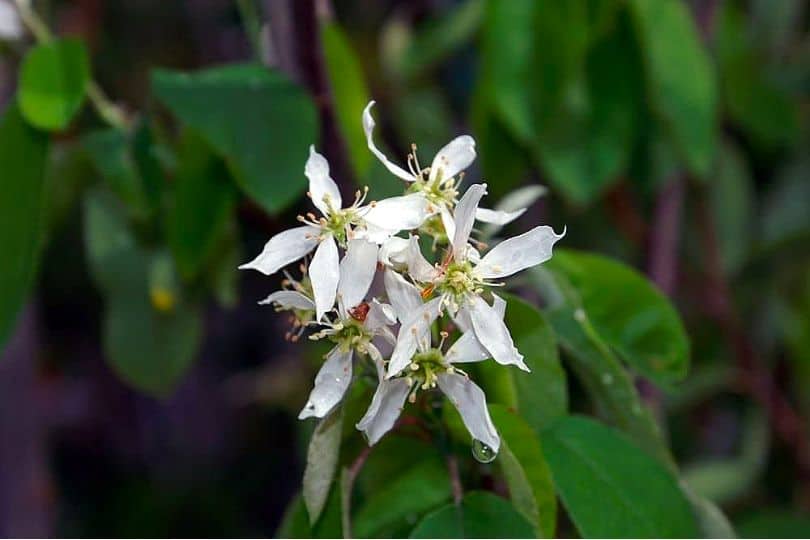
- Scientific Name: Amelanchier canadensis
- Common Name(s): Shadblow Serviceberry
- Mature Height: 6 to 20 feet
- Native Region: Eastern North America, particularly in wet bogs and swamps
- Flowers: White, borne in erect 2- to 3-inch-long racemes in early spring
- Fruit: Round, less than ½-inch in diameter, purple to red, sweet, and attractive to wildlife
- Uses: Fruits are used in pies, and sweetbreads, and can be dried like raisins. Native Americans used the tree’s wood for arrow shafts. The plant is an excellent choice for naturalized gardens, specimen plants, or as a front plant against an evergreen background.
Shadblow serviceberry (Amelanchier canadensis) is a hardy shrub or small tree native to Eastern North America that thrives in wet bogs and swamps. This plant has an upright, multistemmed growth habit and can grow to heights of 6 to 20 feet. Shadblow serviceberry blooms in early spring with stunning white flowers placed on tall racemes, bringing a touch of beauty to Kentucky settings.
The leaves of the plant are alternating, simple, and highly serrated, ranging from 112 to 212 inches in length and 12 to 11/4 inches in breadth. These leaves are medium to dark green in the summer and change to vivid hues of yellow, gold, orange, or red in the fall, adding to the visual appeal of the environment.
Shadblow serviceberry fruits are small, spherical, and less than 12 inches in diameter. They have a delicious flavor and range in hue from purple to crimson, making them appealing to wildlife. These fruits have a variety of culinary applications, including pies and sweetbreads, and can also be dried in the same way that raisins are. Native Americans also used the straight wood of the shadblow serviceberry to make arrow shafts, illustrating the plant’s historical importance.
Shadblow serviceberry is a hardy plant that can resist winter temperatures in USDA Zone 3. It prefers moist, well-drained, acidic soil and grows best in full sun or light shade. While pruning is rarely necessary, occasional thinning of several stems can improve the appearance of the trunk. This plant is pest-resistant, although it should be checked for fire blight.
Shadblow serviceberry fulfills several functions in Kentucky landscapes. It is a fantastic choice for naturalized gardens due to its attractive white blossoms, colorful fall foliage, and wildlife-attracting fruits. It can also be used as an eye-catching specimen plant or strategically positioned in front of an evergreen backdrop to improve the overall appearance of the environment.
4. Sugar Hackberry

- Scientific Name: Celtis laevigata
- Common Name(s): Sugar Hackberry
- Mature Height: 60 to 80 feet
- Native Region: Southern Indiana and Illinois south to Florida and Texas
- Flowers: Small male, female, and bisexual flowers on the same plant
- Fruit: Edible, berry-like fruit, orange-red to blue-black and sweet
- Uses: Commonly used as a shade tree, attracts birds and squirrels with its fruits
Sugar hackberry, or Celtis laevigata, is a hardy tree native to the southeastern United States. Because of its versatility and attractive appearance, it is a popular choice for Kentucky landscapes. The bark on this tree is smooth gray and may develop a corky texture as it ages. It grows to a mature height of 60 to 80 feet, with a rounded crown and spreading pendulous limbs.
Sugar hackberry flourishes in its natural habitat along stream banks and river flood plains, demonstrating resilience in both wet and dry circumstances.
Because of its versatility, it is well-suited for urban areas where it can endure shocks and compacted soils. The tree produces little male, female, and bisexual flowers on the same plant, but its tasty, berry-like fruits are the main appeal. These fruits, which range in hue from orange-red to blue-black and are tasty, are popular among birds and squirrels.
Sugar hackberry may be grown in a range of soil conditions in Kentucky, including clay soils common in river flood plains. It can withstand both direct sunlight and partial shade. It is crucial to note, however, that the tree may develop chlorosis in high-pH soils.
Sugar hackberry has thin wood that might shatter under such forces, therefore it should be used with caution in areas prone to heavy snow, ice, or wind. Additionally, even though wildlife enjoys the tree’s fruits, they can produce an excessive number of seedlings, which could turn into a weed nuisance.
Sugar hackberry is a widespread berry tree in Kentucky due to its endurance and ability to attract local fauna. Because of its flexibility to different soil types and conditions, it is a popular choice for both urban and natural environments.
Native Berry Trees In Kentucky – Frequently Asked Questions (FAQs)
Let’s take a look at some of the most frequently asked questions about native berry trees in Kentucky.
What are some of the native berry trees in Kentucky?
Allegheny Serviceberry, Downy Serviceberry, Shadblow Serviceberry, and sugar hackberry are the most common native berries found in the state.
What are the uses of common berry trees in Kentucky?
Berry trees in Kentucky serve a variety of functions. Blackberries, which are plentiful in the state, are not only eaten fresh but also used to make jams, pies, and desserts. They contain a lot of antioxidants and vitamins. Red Mulberries are prized for their sweet flavor and are eaten fresh or preserved.
American Elderberries are used in herbal remedies, jams, and wines because of their medicinal properties. Wild Strawberries, though small, are flavorful and used in culinary creations. Aside from human consumption, these berries support local wildlife and the ecosystem. Their culinary, medicinal, and ecological importance highlights their multifaceted role in the natural and cultural landscape of Kentucky.
Similar Articles
- Maple Trees In Kentucky
- Dogwood Trees In Kentucky
- Oak Trees In Kentucky
- Hickory Trees In Kentucky
- Ash Trees In Kentucky
- Cypress Trees In Kentucky
- Pine Trees In Kentucky
- Elm Trees In Kentucky
- Magnolia Trees In Kentucky
- Birch Trees In Kentucky
- Cedar Trees In Kentucky
- Locust Trees In Kentucky
Sources
The Regional Gardening team makes sure that the information in our articles is accurate by only using sources that are known to be trustworthy. Some of these sources are peer-reviewed journals from government agencies, well-known universities, and scientific research organizations.
- Common Kentucky Trees, Department of Forestry & Natural Sources, University of Kentucky
- Native Trees Of Kentucky, Department of Horticulture, University of Kentucky.
- Trees & Shrubs of Kentucky, Book By Mary E. Wharton and Roger W. Barbour, University Press Of Kentucky


